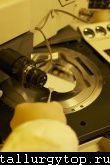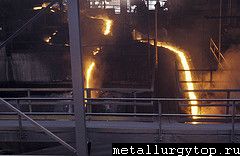Регионы Украины подписали договоры с регионами России
 Впервые за 20 лет, наверное, в таком мощном представительстве делегация Украины была на территории Уральского федерального округа", – сказал он, добавив, что это очень мощный округ в промышленном отношении. В него входят 6 субъектов Российской Федерации и 4 области. Там сосредоточены, металлургия, машиностроение и добыча углеводородов. «Порядка 40% валового продукта России дает Уральский автономный округ», – отметил С. Дергунов.
Впервые за 20 лет, наверное, в таком мощном представительстве делегация Украины была на территории Уральского федерального округа", – сказал он, добавив, что это очень мощный округ в промышленном отношении. В него входят 6 субъектов Российской Федерации и 4 области. Там сосредоточены, металлургия, машиностроение и добыча углеводородов. «Порядка 40% валового продукта России дает Уральский автономный округ», – отметил С. Дергунов.
Он также подчеркнул, что по своему развитию Екатеринбург во многом похож на Донецк. «По тем же принципам новый аэропорт, здание аэровокзала новое современное, дороги в приличном очень состоянии, интенсивное строительство ведется», – сказал С. Дергунов.
По его словам в ходе программы представители украинских областей подписали соглашения с регионами России. У Донецкой области такой договор уже есть. В то же время С. Дергунов отметил, что это была первая встреча и договоры содержали основные положения о сотрудничестве, и никакой конкретики не было. Параллельно представители бизнеса также налаживали отношения.
С. Дергунов отметил, что по отношению к украинской делегации было очень позитивное отношение, и выразил уверенность, что будет позитивное продолжение. Кроме того было принято решение такие встречи на уровне регионов продолжать. Обе стороны выразили заинтересованность в таких встречах.





Commotion with Corrosion
 This is not another boring science topic that will put you off to
sleep. Trust me, I'll make this as simple and as interesting read as
possible.
This is not another boring science topic that will put you off to
sleep. Trust me, I'll make this as simple and as interesting read as
possible.
Corrosion's dictionary meaning is synonymous to a list of words like rusting, corroding, erosion, a chemical process, a chemical change, a chemical action a natural activity, deterioration of metals through the process of oxidation or chemical action.
Whew!
To explain it further, corrosion is defined as the wearing away of materials in a slow blow by blow process. It does not literally pertain to the destruction of metals and other related materials.
Corrosion is then followed by reversion to a more subtle and balanced pairs or combination where metals are known as the most popular examples. Corrosion, in short, is the opposite of metallurgy.
Because while metallurgy is the molding and making of metals, corrosion on the other hand, is the rusting, corroding and unmaking of metals caused by a chemical reaction between the metal and its external faculties which makes up its environment.
Corrosion, in its broadest studies are subdivided into a number of categories with each type processing a different characteristic from the other.
But for a more comprehensive study and understanding of corrosion, scientist have specifically classified corrosion into 2 general and most known types and methods in which the process of unmaking the metals can take place.
The first of which is "typified corrosion" whereby metal iron is exposed to its external agencies during which the temperature is high or eleveated. During typified corrosion, the corroding and rusting of the metal begins as soon as the oxygen in the atmosphere to produce 'mill scale', a common product formed whenever oxygen reacts with its surroundings.
Mill scale and magnetite, which plays a vital role in the method of typified corrosion, contains the same chemical composition called iron ores.
Other forms of metals behave in the same way when associated to its external environment, they also produce varieties of oxides and may have the tendency to behave in the similar manner to come up with other compounds.
All of these chemical reaction and activity points to summarize that the result of direct combination between the given reacting elements results to products of corrosion, and does not plainly embody the end product formed through the substitution of or displacement of an element for or by another element.
However, the second type and method of corrosion is referred to as "galvanic" corrosion or "electrochemical corrosion".
This method is characterized by the process of displacement of one given element in one phase (usually in the form of alloy or metal). And since electric current is the focal point of the variable displacement of one given element by the other given element, literally defining the very meaning of galvanic or electrochemical corrosion.
Furthermore, electrochemical corrosion generally refers to cases of corrosion in which metal or alloy being rusted is continuously associated and linked with the corrosion-causing solution, or another given element that is a dissimilar metal or may also be some different conducting or solid material.
The term electrochemical corrosion may also be used in
cases when either pure metal, impure metals, or other forms of metal or
alloys are exposed to pure water, aqueous solution of water soluble
materials, or different mixtures of water with other elements which is
both not soluble nor a solvent of water.
Corrosion will not take place in the absence of corrosion cells. In a more simplified situation, it's like a cheeseburger without cheese. Before such corrosion cells do their function, some pre-requisites must be met.
First requirement is for cells to have doors to connect two points, the metal and the solution, to allow the flow of electric current to and from each other in the metal surface.
Second, the cell must be capable of electric conductivity. And lastly, there must be a motivating force or 'push' that will enable the initiation (first step), and maintenance (second step) of flow of current all throughout the system.





Alloying Elements in Titanium
 In the solid state, the titanium alloys are arranged in either hexagonal close–packed (alpha) or body–centered cubic (beta) structure. Pure titanium undergoes an allotropic transformation from hexagonal close–packed (HCP) alpha titanium to body–centered cubic (BCC) beta titanium as its temperature is raised through 882 °C (1620 °F). The melting point of pure titanium is 1668 °C (3034 °F).
In the solid state, the titanium alloys are arranged in either hexagonal close–packed (alpha) or body–centered cubic (beta) structure. Pure titanium undergoes an allotropic transformation from hexagonal close–packed (HCP) alpha titanium to body–centered cubic (BCC) beta titanium as its temperature is raised through 882 °C (1620 °F). The melting point of pure titanium is 1668 °C (3034 °F).
Aluminum is the most widely used alloying element in titanium–based alloys. It is the only common metal that raises the beta transus temperature and have large solubilities in both the alpha and beta phases.
Elements such as aluminum, oxygen, nitrogen, carbon, gallium, germanium, lanthanum, and cerium stabilize the alpha phase to higher temperature and are thus referred to as alpha stabilizers.
In general, transition metals and noble metals (i.e., metals which, like titanium, have unfilled or just–filled d–electron bands) are stabilizers of the beta phase to lower temperatures and are thus referred to as beta stabilizers.
Beta stabilizers are subdivided into two groups: beta–isomorphous (e.g. vanadium, niobium, tantalum, molybdenum, and rhenium) and beta–eutectoid (e.g., copper, silver, gold, palladium, indium, lead, bismuth, chromium, tungsten, manganese, iron, cobalt, nickel, uranium, hydrogen, and silicon).
Vanadium, molybdenum, and niobium are the most frequently used beta–isomorphous forming elements in titanium–based alloys. These elements, when added in sufficient concentrations, can stabilize the beta phase to room temperature. Tantalum and rhenium, which are also beta–isomorphous forming elements, are rarely used, mainly due to their high densities.
Chromium, iron, and silicon are the only beta–eutectoid forming elements that are commonly used in many titanium–based alloys.
Zirconium, hafnium, and tin form a group of alloying elements known as neutral additions. These three elements are sometimes classified as beta stabilizers, as they depress the beta transus temperature (albeit only slightly) in their respective binary phase diagrams with titanium. Zirconium and hafnium are isomorphous with titanium and exhibit the same beta to alpha allotropic phase transformations. These two elements have complete solubilities in the alpha and beta phases of titanium. Tin is a beta–eutectoid forming element and its effect on the beta transus temperature is negligible for all practical purposes.
When added to alpha–matrix alloys, however, neutral additions such as zirconium and tin can take on the characteristics of alpha stabilizers (e.g., aluminum). This is because of the chemical similarity of zirconium to titanium and because tin can substitutionally replace aluminum in the Ti3Al phase.




